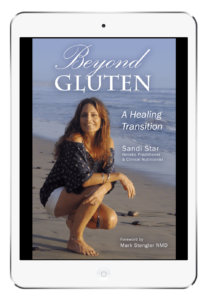24 Jan Gluten and Inflammation
A Major Cause of Inflammation is Gluten
After struggling for over 40 years with chronic migraines, IBS, muscle and joint pain, fatigue, brain fog, asthma and a slew of other ailments and frustrations, I decided to take a closer look at the cause rather than obsessing on the symptoms. I was tired of relying on doctors to give me answers and tired of the medications that only gave me side effects and little relief.

I had been committed to health and fitness for over 20 years, losing close to 60 pounds and 6 dress sizes, however I still had all the chronic conditions that played havoc in my life. I realized there was a key element missing and soon found out it was my reaction to gluten and dairy. I didn’t know enough about food intolerance or allergies or at least put the two together. I never believed food could have such a serious impact on overall health let alone be the direct cause of my diseases. With what I know today I’m surprised my doctor didn’t put the connection together when he diagnosed me with Sjogren’s syndrome (autoimmune disease). Sjogren’s is one of the symptoms of Celiac along with a long list as you will see below and nutrition plays a critical role in the healing process. By making the appropriate diet changes – (gluten and dairy free), I’ve managed to eliminate my migraines, IBS………etc., etc., and have the Sjogren’s syndrome under control. Even better, I have eliminated all medications and use food and natural remedies for nutrition and overall health. Now that you know why I became a clinical nutritionist and why I started Karmic Health let’s get into the details of why it’s so important to understand gluten and its relation to diseases.
What is Gluten?
Gluten is a composite of the proteins gliadin and glutenin. These exist, conjoined with starch, in the endosperms of some grass-related grains, notably wheat, rye, and barley.
Understanding what happens in the body and some of the symptoms will help millions of people who go undiagnosed. Celiac is the most common genetic disease of mankind (yet for every person diagnosed, 140 will go undiagnosed).
Why the problem with gluten now?
A lot has changed in the way we harvest food compared to 50 years ago. Some of the seed companies began engineering wheat kernels that could be more easily ground and produce fluffier flour to make the soft, delicious white bread, for example, have greater yields; it made more money for the farmer and increased sales.
The best way to explain gluten and why it’s become such a series problem in our diet is to think of an eraser on a pencil tip. That is the amount of gluten that was in wheat before Hybridization. Now think of the actual pencil. That is the amount of the gluten protein in wheat now. Again, 500 fold increase. Our body does not know how to digest that much protein. Subsequently it stores in our fat cells as toxin. Here’s the scoop.
In 1943, the International Maize and Wheat Improvement Center (IMWIC) wanted to help Mexico achieve agricultural self-sufficiency which grew into a world-wide effort to increase the yield of corn, soy and wheat. Hybridization took over and soon, many different strains of wheat were being planted and harvested. By 1980, thousands of new strains of wheat had been produced. These new varieties were geared toward:
- Making the plant resistant to environmental conditions
- Greater resistance to pathogens such as fungus
- Increased yield per acre, tenfold greater than farms of a century ago
The results created top-heavy plants; grain losses occurred as plants could not withstand the weight. Continued manipulation produced smaller plants considered “dwarf” wheat. More than 99% of wheat crops are now “dwarfed,” growing to only 18” tall. Non-hybridized (organic in this case) wheat grows naturally to 4.5 feet tall. Despite increases in crop yield, no animal or human safety testing had been conducted on these new strains of wheat. Tens of thousands of products were released into the food supply unquestioned. Assumption was that altered protein structures, enzymes and gluten content would have no human consequence. It was later discovered that wheat gluten proteins had the most significant changes. In one study, fourteen new gluten proteins were identified in the offspring and not present in either parent. These never-before-seen gluten proteins now being discovered are foreign to the body. Some estimates suggest that the hybridization and genetic engineering of wheat has resulted in an up to 500 fold increase in wheat gluten produced today. This may be one of the primary reasons behind the massive rise in incidence of wheat gluten intolerance, celiac disease and other autoimmune conditions in recent decades. The New England Journal of Medicine listed 55 “diseases” that can be caused by eating gluten!!!
Many of the diseases are neurological and psychiatric. Among them are depression, schizophrenia, epilepsy, migraines, neuropathy, anxiety, dementia, and autism.
Definitions of Intolerance
A wheat allergy is the body’s abnormal autoimmune response to a certain protein component of wheat; it’s exhibited by a severe sudden onset allergic reaction. Usual symptoms are immediate coughing, asthma, breathing difficulties, and/or projectile vomiting. It can cause life-threatening responses in allergic people. A true Wheat allergy affects less than 1/2 % of population.
Intolerance’s are much more common than true food allergies but are harder to diagnose. Food intolerance is an adverse reaction to food that does not involve the body’s immune system. Generally food intolerance is an inability to properly digest certain foods. In some cases food passes right through the body before digestion is complete.
Leaky Gut is an increase in permeability of the intestinal mucosa to luminal macromolecules, antigens, and toxins associated with inflammatory degenerative and/ or atrophic mucosa or lining. Put more simply, large spaces develop between the cells of the gut wall allowing bacteria, toxins and food to leak into the bloodstream. Leaky Gut Syndrome has also been linked with many conditions, such as: Celiac Disease, Multiple Sclerosis, Fibromyalgia, Autism, Chronic Fatigue Syndrome, Irritable Bowel Syndrome, Eczema, Dermatitis, and Ulcerative Colitis.
Celiac disease is an autoimmune disease caused by an inappropriate immune response to dietary proteins found in wheat, rye, and barley (gluten and gliadin). This response leads to inflammation of the small intestine and to damage and destruction of the villi that line the intestinal wall. These villi are projections (small folds) that increase the surface area of the intestine and allow nutrients, vitamins, minerals, fluids, and electrolytes to be absorbed into the body. When the villi are destroyed, the body is much less capable of absorbing food and begins to develop symptoms associated with malnutrition and malabsorption. When the body is exposed to the gluten and gliadin proteins, it forms antibodies that recognize and act against not only the grain proteins, but also against constituents of the intestinal villi. As long as the patient continues to be exposed to the proteins, he will continue to produce these autoantibodies. Celiac disease is found throughout the world but is most prevalent in those of European descent. It can affect anyone at any age and is more common in women. It is thought to be an inherited tendency that is triggered by an environmental, emotional, or physical event – although the exact mechanism is not fully understood.
According to the National Digestive Diseases Information Clearinghouse, about 5 to 15% of close family members of a celiac disease patient will also have the condition.
One of the questions I have is if someone gets a negative test for celiac should they still go gluten free. My answer is yes. If you are experiencing any of the symptoms you are more than likely gluten intolerant. Most of the population fits in that category including me. I recommend doing the 45 – 60 day challenge. Try going gluten free and pay attention to your health. If you see changes and feel better you are better off gluten free. You just have to make sure you eat a healthy gluten free diet.
Symptoms
There are literally dozens, if not hundreds, of symptoms of gluten intolerance. It all comes down to inflammation in the body! Many people believe the most common symptoms are gastrointestinal in nature – yet the majority of people with gluten intolerance (and celiac disease) have extra intestinal symptoms.
The most common symptoms of celiac disease include:
• Fatigue
• Addison’s disease (hormonal disorder)
• Gastrointestinal distress (gas, bloating, diarrhea, constipation, vomiting, reflux)
• Headaches (including migraines)
• Infertility
• Mouth sores
• Weight loss/gain
• Inability to concentrate
• Moodiness/depression
• Amenorrhea/delayed menarche (menstrual cycles)
• Bone/joint/muscle pain
• Dental enamel hypoplasia (dental enamel defect)
• Short stature
• Seizures
• Tingling numbness in the legs
The “cure” is a lifelong gluten free diet (100%).
Making the Transition
1. Have a reality check. Remember this is a choice. If you want to feel lousy for the rest of your life and get worse as time goes on then continue eating gluten. If you want to start on a journey to heal; go gluten free.
2. Give it time. It takes time to heal and it takes time to transition into a new routine. Take the 45-60 day challenge.
Within this time frame you will notice the brain fog is gone. Your body will start adjusting to a healthy weight. Yes, you will lose the bloating and weight around the middle. Don’t be discouraged if it takes a little longer to feel 100%.
3. Look at your current diet and go through your pantry and refrigerator to find the foods and meals you already eat that are gluten-free. You may need to keep a food journal if you haven’t already.
Be sure to list condiments, ice creams, produce, snacks, and other foods.
This list will be helpful as you create menus around your new foods and give you encouragement that you’re already on the right track!
4. Give yourself permission to eat; for some people, having things that you may have restricted from your diet before your diagnosis. Potato or rice chips or GF cookies may not be appropriate for other people, but they are a treat in a GF diet in small doses of course. You will need to find treats for yourself initially as you adjust to this diet. Count calories if you have to after you are comfortable with your new way of eating, manage your portions instead. This is a rule of thumb I live by. I don’t count calories, I count food.
Once you are comfortable with the switch start cutting back on refined grains, crackers, breads, etc., to help the gut heal quicker. In all honesty, bread will not be that important. It’s all about taking baby steps!
5. Look at your current menus and meals and find ways to eliminate gluten from your diet. Replace bread in sandwiches with GF bread or green leaf lettuce and add your favorite fixings and condiments. Have breakfast burritos with rice tortillas instead of toast and eggs. Look for GF hot and cold cereals (must not have barley malt) and have those handy for a snack or meal. Replace bread and crackers with tortilla or corn chips, brown rice cakes or popcorn. For example, chicken or tuna salad on rice cakes or scooped onto corn chips is delicious. Popcorn is a filling side dish with soup. Be on the lookout for meals on your current menus or the menus of friends and family that are naturally gluten-free (roasted chicken, baked sweet potatoes and steamed veggies, for example) and make them a staple on your new menus. Surf the internet, watch cooking shows and browse magazines for ideas and adapt them as you see fit.
6. Clear out any and all foods that have gluten, wheat, wheat flour, oats, oat flour, rye, semolina, or modified food starch from your pantry. This will allow you to see how close you are to living gluten-free already. If you have family members living with you who are not gluten free, you might consider giving the “offending edibles” to them to be put in another part of the house while you learn to live and think gluten-free. As time goes on you can cook for the entire family without gluten.
7. Plan and prepare your meals ahead of time. Being caught hungry without a plan is not a good idea! Keep a few GF soups on hand in case of extreme hunger. Keep a small cooler in your car with snacks such as nuts, dried fruit and water. It helps to outline and pack any meals you’re eating at home and away from home, including snacks.
An example could be:
* Breakfast: scrambled eggs and mixed vegetables rolled in a rice tortilla and sliced apples or berry medley.
* Lunch: Lettuce with turkey, avocado slices, tomato, sunflower sprouts, and mustard, 1 oz. organic corn chips, and 2 organic dark chocolate pieces.
* Dinner: Grilled salmon or white fish with mixed vegetables, wild rice, and fruit.
* Snacks: 1 oz. almonds or organic popcorn.
* Desert: Coconut Ice Cream
Tips
1. Be patient with yourself. You’ll have days when being gluten-free is really depressing (maybe even “fall off the wagon”). This is normal.
Relax – it’s a process.
2. Carry snacks with you wherever you go. It’s often difficult to find an appropriate snack when the hunger strikes. GF bars are great!
3. Arrange with the hosts of gatherings you may attend to bring your own sides or complete meals. Most people are very supportive of restricted diets.
4. Carry a small cooler in your car with small cold packs to store nuts, healthy bars, fruit, snacks and water.
5. Consider avoiding restaurants during your transition phase as you learn how to eat and think gluten-free. Grilled meats (over a flame), baked potatoes and salads without croutons are usually safe bets. But keep a log of places you eat, what you ate and how you felt afterward. Gluten is insidious and can turn up in the oddest places (french fries, for example which can be dusted with flour).
6. Get your hands on cookbooks or start collecting your own recipes in a binder. Keep them in clear inserts so you can wipe them off easily.
7. Carry digestive aids (enzyme and bioflavonoid) with you in case of accidental ingestion. There are ones specifically for gluten such as GlutenFlam by Apex Energetics; available from your healthcare practitioner or Karmic Health.
8. Consider taking a multi-vitamin to make up for vitamins and minerals you may lack with your new diet (ask your doctor or nutritionist if necessary).
9. Find a mentor or support system.
10. Breathe
Other Foods to consider eliminating to help heal the gut and reduce inflammation
Dairy (Casein)
Casein is a milk protein, which has a molecular structure that is extremely similar to that of gluten. Casein is frequently found in otherwise nondairy cheese substitutes to improve consistency, especially when melted so be careful in reading nondairy labels. An example is almond cheese. It has casein. Since casein has a molecular structure that is so similar to that of gluten, most gluten-free diets are combined with casein-free diets and referred to as a gluten-free, casein-free (GFCF) diet. Other names for Casein is often listed as sodium caseinate, calcium caseinate or milk protein. There are dairy free options such as Ghee butter which is clarified butter, coconut spread, coconut milk and almond milk. There are some cases where goat or sheep milk cheeses, milks and yogurts work in the diet. The proteins are smaller and easier to digest.
Soy
Many families avoid soy protein because the soy protein molecule is reported to be similar in make up to the gluten and casein molecules. Some people do well with soy lecithin because there are only trace amounts of the protein. You will have to find out through your own trials. Soy is estrogenic and an inflammatory food. Most soy in the US is genetically modified (GMO) which is not a good thing.
Just know that it’s not uncommon for your body to be sensitive to gluten, dairy and soy.
About the author: Sandi Star, HHP, CNC, CCMH
Sandi is the founder of Karmic Health, specializing in nutrition related to disease where a gluten and casein (dairy) free lifestyle is crucial; working with celiac, autism and all auto immune disorders. Sandi graduated from The Natural Healing Institute with a degree in Clinical Nutrition and Master Clinical Herbalist. She has hands on understanding of many health issues and has dedicated her life in helping others reach their optimal health.


